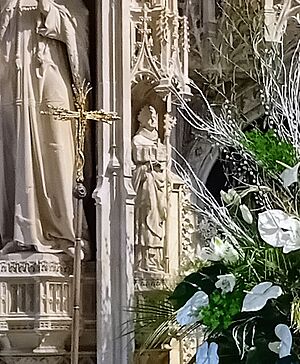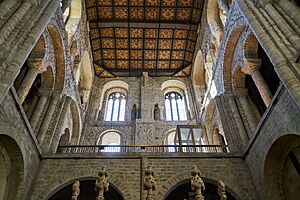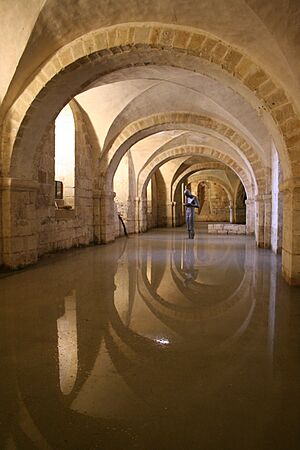Walkelin facts for kids
Quick facts for kids Walkelin |
|
|---|---|
| Bishop of Winchester | |

Statue of Walkelin on the Great Screen of Winchester Cathedral
|
|
| Appointed | 23 May 1070 |
| Reign ended | 3 January 1098 |
| Predecessor | Stigand |
| Successor | William Giffard |
| Orders | |
| Consecration | 30 May 1070 by Ermenfrid |
| Personal details | |
| Died | 3 January 1098 |
| Buried | Winchester Cathedral |
| Denomination | Catholic |
Walkelin was an important Norman leader who became the first Bishop of Winchester after the Norman Conquest of England. He is famous for starting the building of the huge Winchester Cathedral in 1079. He also made changes to how the cathedral was run. Walkelin was very active in the government of England, even serving as a temporary ruler (called a regent) for a short time.
Contents
Becoming a Bishop
Walkelin was likely a priest (called a canon) at Rouen Cathedral in France before the Normans took over England. He worked for William the Conqueror, who was the first Norman King of England, as a special advisor or chaplain.
In April 1070, a meeting was held in Winchester. Important church leaders sent by the Pope (called papal legates) removed Stigand from his role as Bishop of Winchester. Stigand had been removed because he held too many important church jobs at once, which was against the rules. Walkelin was chosen to be the new Bishop of Winchester on May 23, 1070. He officially became bishop a week later, on May 30, in a special ceremony led by one of the papal legates, Ermenfrid.
Bishop of Winchester
Changes at the Cathedral
Walkelin wanted to make big changes at Winchester Cathedral. He planned to replace the monks who lived and worked there with priests. This change would have given him more control over the cathedral's money. He had the king's permission for this plan.
However, Lanfranc, who had just become the Archbishop of Canterbury, stopped Walkelin's plan. Lanfranc was a monk himself and did not want to see monks replaced. To get money for his projects, Walkelin divided the cathedral's wealth between himself and the monastery. He also took some of the monks' land and power. To make this easier, he made his brother, Simeon, the head monk (called the Prior) of Winchester.
Despite these changes, old records from Winchester say that Walkelin improved the cathedral and monastery. They mention that he made the monks more devoted and increased their numbers. He also improved the buildings of the monastery.
Building Winchester Cathedral
In 1079, Walkelin started building a brand new cathedral, which is the Winchester Cathedral we see today. It was meant to replace the older church, the Old Minster. Walkelin's new church was enormous, almost 180 yards long! It was built in a style called Romanesque, which uses thick walls and round arches.
Some parts of the cathedral you can still see today were built by Walkelin. These include the two side sections (called transepts), the underground room (called the crypt), and parts of the main area where people sit (called the nave). The main tower of the cathedral fell down in 1107 but was rebuilt later.
In 1093, the monks moved into the new parts of the building. They also moved the special container (called a feretory) holding the bones of Saint Swithun into the new church. After this, the old Minster was torn down. It's thought that the first building work was finished around 1122 by the next bishop, William Giffard.
There's a fun story about Walkelin getting wood for the cathedral. In 1086, King William I (William the Conqueror) supposedly told Walkelin he could take as much wood from a certain forest as his carpenters could cut in three or four days. Walkelin gathered many carpenters and cut down the entire forest in that time! The king was very angry. Walkelin quickly put on an old cloak and begged the king to forgive him. The king was pleased by this and Walkelin remained bishop. This story shows that Walkelin and King William were good friends.
Walkelin's Role in Politics
Walkelin was an important church leader not just in Winchester, but across England. He helped make Lanfranc the Archbishop of Canterbury. He also attended important meetings and signed important agreements, like the Accord of Winchester. He helped move the bones of famous saints like Saint Edmund and Saint Botolph. He also gave special permission (called an indulgence) to people who visited Saint Edmund's shrine.
Like many Bishops of Winchester, Walkelin was involved in royal politics. He signed many official papers for both King William I and King William II. Walkelin was one of King William II's most trusted advisors. He seemed to be in charge of the king's money, overseeing the royal treasury in Winchester Castle.
In 1096, he was in charge of a court circuit, hearing royal cases. He also helped organize a tax collection (called the geld) that year. He tried to help solve a disagreement between Anselm of Canterbury, the Archbishop of Canterbury, and King William II.
Walkelin was also involved in the start of St Giles's Fair in Winchester. This fair became one of the biggest medieval fairs in England and was very important for Winchester's economy. In November 1097, Walkelin even served as a temporary ruler (a regent) of England with Ranulf Flambard while King William II was away in Rome.
Death
Walkelin died on January 3, 1098. He was buried in the main part of Winchester Cathedral. His tombstone had a short poem in Latin, which translates to:
- "Bishop Walkelin rests here interred"
- "Enthroned in the time of William the Conqueror"
Family
Walkelin had a brother named Simeon. Simeon was a monk and later became the head monk (Prior) of Winchester. Walkelin made Simeon the Prior, which helped him make changes to the cathedral's wealth. Simeon later became the head of Ely Abbey and started building the current Ely Cathedral.
Walkelin also had a nephew named Gerard. Gerard was a church leader in France before becoming the Bishop of Hereford in England. He later became the Archbishop of York. Gerard also served as the king's chief secretary (called the Lord Chancellor) for several years under both King William I and King William II.



